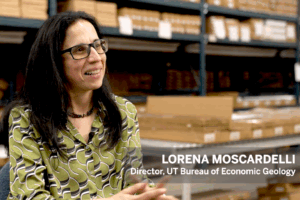Brian Baldwin, a retired army officer and project manager for the Texas Combat PTSD Risk Project, knows first-hand the consequences of Posttraumatic Stress Disorder (PTSD).

His best friend and cousin, a serviceman in Vietnam, took his own life as a result of the mental disorder.
“We grew up together,” Baldwin said. “I went off to college and ROTC, then into the army, and he worked for about a year or two and then went to Vietnam. When he came back he was just a different guy.
“Looking back on that, I realize now that he had PTSD, and I wasn’t able to do anything about it.”
Baldwin said it was his cousin’s death that inspired him to further examine the predispositions and susceptibility to combat PTSD.
“I want to know why Chuck went off to Vietnam and got PTSD and why Brian didn’t get PTSD,” he said.
During the past few years, soldiers have been bused from Fort Hood to Dr. Michael Telch’s anxiety disorders research lab to help determine the factors that may predispose service members to PTSD.

More than 160 Iraq soldiers have completed the three phases of the study, which assesses service members prior to deployment, during deployment and after returning home from combat.
“One of the strengths of the study is that unlike just giving a questionnaire when soldiers get back from deployment, we have the opportunity to assess them before they leave,” said Telch, principal investigator for the study and a professor in the Department of Psychology.
Unlike previous studies that focused on retrospective data, this one is a multisystem approach that allows comprehensive assessment of possible risk factors through every phase of deployment.
Baldwin said he hopes the multi-faceted approach will help identify individual susceptibilities in soldiers prior to deployment.
“If we could identify biomarkers that predispose an individual to PTSD then we could inoculate them in some way–develop training programs that would help them deal better with those stressful situations,” Baldwin said. “We could also identify those individuals so that maybe they would be watched closer so then if a traumatic incident occurs they would get a little bit closer observation.”
The pre-deployment assessment includes full neuroimaging at the Imaging Research Center, DNA collection, comprehensive clinical interviews, dozens of validated questionnaires, an eye tracking assessment and a carbon dioxide stress test where the subjects inhale a mixture of 35 percent CO2 and 65 percent oxygen for 30 seconds.
“(The carbon dioxide stress test) is a major stressor,” Telch said. “What we do is we assess their reactions subjectively, and their hormonal response–their cortisol and testosterone responses to the challenge–and we ultimately want to link their reactions to their risk for developing combat stress problems in theater.”
Telch said the eye-tracking assessment is a computer test that monitors the soldier’s eye movement when presented faces expressing different emotions. He said one face could be happy, one face could be sad and another could be angry. The test monitors were the soldiers look most frequently.
The second part of the study takes place once the soldiers have been deployed. Service members have access to a Web-based system where they can fill out an online questionnaire every 30 days.
The questionnaire is divided into two parts. The first one assesses any stressors or stress experiences the combatants have been exposed to–such as witnessing a car bomb or participating in a firefight. After indicating exposures, soldiers are asked to specify which experience caused them the most stress. Part two of the questionnaire asks about individual stress reactions. Telch said soldiers are provided a list of symptoms related to PTSD, depression and anxiety, and asked to rate each item in terms of how severe they have experienced the symptoms in the previous 30 days.
“Rather than waiting for soldiers to come home and ask them how they have been doing, we are able to track in real time, while they are still in the combat zone, which is a new innovative piece of the puzzle,” Telch said.

When soldiers do come home, they return to the anxiety disorders lab to do a day of assessments similar to the pre-deployment stations.
Telch also conducts one-on-one interviews with each participant during the third phase of testing. During these interviews, Telch has been able to craft inferences that he wasn’t expecting, such as how the accessibility to the Internet has caused added stress for combatants.
“When you think about earlier wars, you got a letter once in a while, but the way it is working now, not only are the soldiers having to experience the stress of being away from home and all of the stressors related to combat, but they also get bombarded with the stressors from back home because of the Internet,” Telch said. “So they are getting e-mails all of the time, and there have been some real horrendous horror stories.”
Telch said the first soldier to return out of the study participants tried to commit suicide because he had heard from a friend via e-mail that while he was gone his wife had moved in a boyfriend.
Another soldier expressed the guilt he felt after witnessing a car explosion and not being able to help the only survivor.
“There was this little girl that was pinned under the car and this one soldier couldn’t come out to help, and just the guilt he felt for watching her die,” Telch said. “It was hard not to cry when he was telling me the story.”
Baldwin said his experience helped the research team develop a protocol to understand how they should talk with the soldiers and what questions should be asked. During his tenure in the Army, Baldwin helped work on capabilities to treat combat stress casualties in the field.
With this insight the team was “able to go in and talk as a peer. (The soldiers) didn’t look at us as outsiders, they were inclusive to us,” Baldwin said.
Telch said he hopes to conduct one-year follow-ups with the soldiers who were deployed to Iraq, and eventually expand the number of service members in the study to 500. He said once his team obtains additional funding, it would switch to soldiers being deployed in Afghanistan.
“In a perfect world we could find the silver bullet–that certain thing,” Baldwin said. “If we could find the thing that would help us eliminate PTSD as a combat injury, that would be huge. That would be huge not only for soldiers, but for the general population because then it could be used to help the hundreds and thousands of civilians that have PTSD within their lives.”



